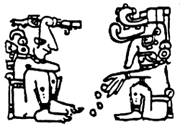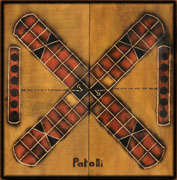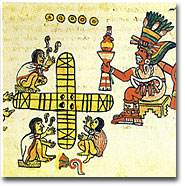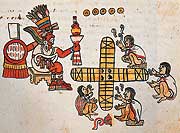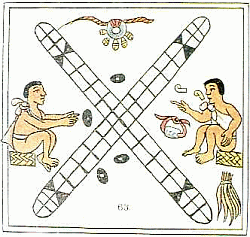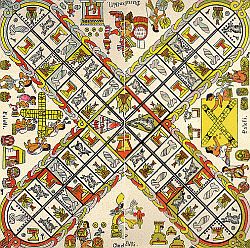| Home Online Freeware Commercial |
|
|||||||
| Pachisi Ludo Parcheesi Parques Parchis Patolli Chaupar Other About Links |
Patolli, the ancient game of the Aztecs, has traditionally been regarded as having the same ancestor as Pachisi (the Pachisi-Patolli theory1). This theory is now generally regarded as incorrect. It is not even conclusively decided if it was a race game or a war game. The argument were based on what seemed to be similar significant features between Pachisi and Patolli and that this game could not have been developed independently on opposite sides of the globe (diffusion). It was also an argument in favor for the highly controversial theory of pre-Columbian trans-Atlantic contact. The alternative explanation of parallelism instead
of diffusion is well argued and preferred by board game historians. It
is also argued that the Pachisi and the Patolli tracks are
fundamentally different2. The Pachisi track is
severely symmetrical, the Patolli track uniquely asymmetrical. The
Patolli track, if opened out, is nothing but a circle, whereas the
Pachisi track is topologically a cross and circle design. The following is all based on Lieve Verbeec's article "Bul: A Patolli game in Maya lowland" from 1998: Before the Spanish Conquest many games of chance using beans or reeds as dice were widespread in Mesoamerica3. But no accurate description has been found of how these games were played (and many sources are contradictory). The Aztec board game of Patolli is still a riddle. But it is generally accepted that the Patolli boards are cosmological images. Originally the term Patolli were only used to describe one specific Aztec game - played on a mat on which there was drawn a cruciform board with four black marked patolli beans as dice (marked with white dots). By now it is a generic term and labels any variant of the square, cruciform or circular game-boards drawn or incised on floors or benches of ancient buildings, or featuring in the multiple pre-colonial or early-colonial codices, as well as some of the the twentieth century games of chance that are assumed to be survivals or variants of the ancient game of Patolli. Patolli has been labeled as a race game by the earlier board game historians. But as Verbeeck claims, it could just as well have been a war game. The earliest Spanish sources referred to both war and race games when they tried to describe Patolli and compared it with native Spanish games. When and where the game of Patolli originated is not clear. It might have existed long before the Aztec period (- AD 1450). Archaeological sources says patolli boards occurred at least ten centuries ago, both in the Maya area as well as in Central Mexico. As a result of a comparative study of four Mexican board games, Verbeeck found the following common characteristics and list the following tentative typology of the patolli games: 1 - the dice - the use of four two-sided lots
which corresponds with the number and characteristics of the patol
beans used in ancient times 4 - team game (always played in two teams of equal numbers) 5 - capture by simple replacement 6 - the circuit - no matter the shape or length of the circuit, the teams have their own entrances on the board 7 - the circuit - the common part of the circuit, where capture is the object of both teams This typology includes both race games and war games. In both types the opponents have to run a circuit. The difference between the two types of games actually only lies in the fact that in the latter games the opponents' counters are not returned to let them enter the circuit again. So the generic term patolli labels both race and war games of Mesoamerican origin. "Still, the question whether the famous Aztec patolli, the "game of mat" was a race game or a war game, remains an intriguing one." (pg. 97) Bul
(buul, boolk, puluc) The Mayan game Bul (as played today in Belize) is a modern variant of Patolli. It is a social ceremonial joyful game. Male farmers play Bul before planting their corn in the spring ("play corn"). Win or loose don't matter, it is only important that the corn, which is going to be planted the next day, should be surrounded by bright joyfulness the night before it will go down into the "dark earth". Played with any even numbers of players above six, in two teams, board marked by twenty grain of floor (corn) in a straight line (continuous circuits). It is played as an war game. The players use a four corn-dice (called bul). The captives keep on accompanying their captors on the circuit and consequently may expect their chances of retakes and liberation. The Maya board game Bul is a survival or modern variant of the ancient patolli games. It's date of origin or how it was originally played is impossible to know.
Notes 1. Originally by Tylor, E. B.: The game of Patolli in Ancient Mexico, and its probably Asiatic origin. In: Journal of the Anthropological institute of Great Britain and Ireland, vol. 8 (1878), pp. 116-131 2. Parlett, 1999, pg. 54 3. Meso-america: The pre-Columbian culture area where different native American people shared common cultural traits. Northern frontier (at it's peak): Rio Grande and southern frontier: east of Nicoya in Costa Rica (Verbeeck, p. 99) Printed sources - Parlett, David: The
Oxford history of Board Games, Oxford
University Press, 1999. ISBN: 0-19-212998-8 Online links: - Wikipedia
entry for Patolli |
|||||||
|
|
[Home] [Online] [Freeware] [Commercial] [Pachisi] [Ludo] [Parcheesi] [Parques] [Parchis] [Patolli] [Chaupar] [Other] [About] [Links] [Comments] [Site log] | |||||||
| © 2005 - 2006 Vegard Krog Petersen |
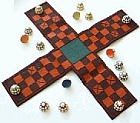
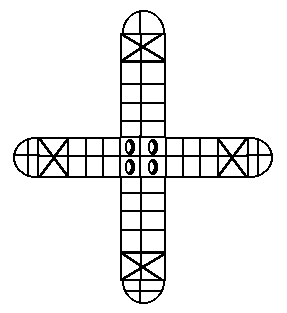 Patolli
Patolli